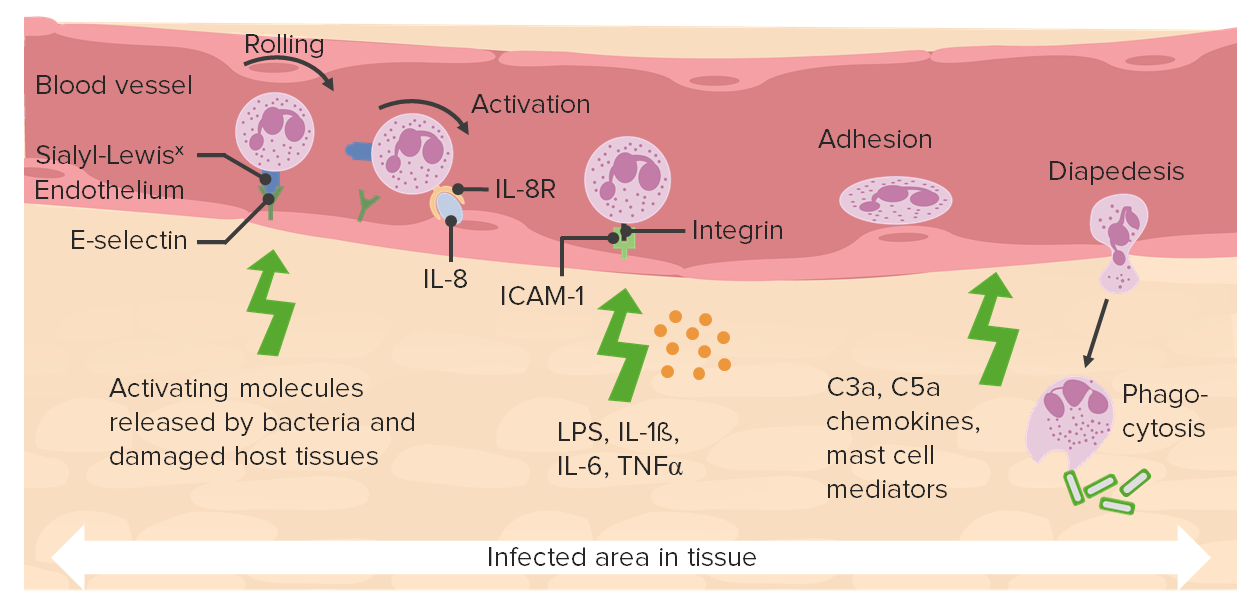Playlist
Show Playlist
Hide Playlist
Innate Inflammation
-
Slides Acute and Chronic Inflammation Overview.pdf
-
Download Lecture Overview
00:01 Big picture items 2. 00:03 So innate inflammation is triggered by "danger." And I have in quotes right now, but we will talk in a bit about what danger is? Does the cell read a sign that says danger? Is there a siren that goes off? No. 00:16 But there are various things that are released in areas of necrosis that tell the neutrophil and the macrophage that there is something wrong. 00:26 So, they are brought in and respond to, "danger." So basically necrotic stuff. 00:34 The inflammatory response, this innate inflammation, proceeds in waves. 00:39 It is not... 00:41 they start, they come on, and they go away, that doesn't happen. 00:45 It's actually kind of a bell-shaped curve for over the period of time that they occur, and they overlap. 00:52 So neutrophils are first on the scene. 00:54 You see them spike there. 00:56 And then after a couple days, there's not a signal that says "More neutrophils. We want them to come in." In general, we move on to the next phase, which is going to be the definitive cleanup, and that's the macrophage. 01:06 So they progress in waves. 01:09 And that's important because if we look at a certain time point, we may see both neutrophils and macrophages overlapping. 01:16 And that's okay. 01:17 That's part of how they come in and do their job. 01:21 They do their job also by amplification cascades. 01:25 So a single neutrophil, or a single macrophage can't do very much. 01:30 But a single neutrophil, if it recruits additional neutrophils can do a lot because now there's a little army of neutrophils. 01:39 Or if a neutrophil makes a mediator that then cleaves other protease of proteins, and makes other mediators, which make other mediators, which make other mediators, pretty soon, we have a whole bunch of mediators from a single cell. 01:52 So cascades, amplification cascades are an important feature of the immune response. 01:57 And it takes a little while to get up to a level of activity that we can actually see. 02:03 Really important. 02:04 This is one of those important biological concepts. 02:07 There's a yin and a yang. There's a pro and an anti. 02:10 And at the same moment that we're doing pro-inflammatory things to clean up an area and start the healing process, we are also doing anti-inflammatory things. 02:20 We are balancing that. 02:22 And if we don't have a good balance between pro and anti, we can have a lot of damage. 02:27 In fact, that's the last point. 02:29 These guys, neutrophils and macrophages make a lot of mediators, they don't care what they're acting on. 02:35 They're not specific for bacteria, or any other pathogen, or not even for necrotic debris. 02:41 They will potentially cause damage to normal tissues in the vicinity. 02:46 So they do have to be carefully regulated to keep that from happening.
About the Lecture
The lecture Innate Inflammation by Richard Mitchell, MD, PhD is from the course Acute and Chronic Inflammation.
Included Quiz Questions
Which of the following best describes innate immunity?
- It works through amplification cascades.
- It involves the activation of cytotoxic T cells.
- It is specific for microbial pathogens and infected cells.
- It has an abrupt onset.
- It has the ability to recognize an antigen that the body has previously encountered.
Customer reviews
5,0 of 5 stars
| 5 Stars |
|
5 |
| 4 Stars |
|
0 |
| 3 Stars |
|
0 |
| 2 Stars |
|
0 |
| 1 Star |
|
0 |




